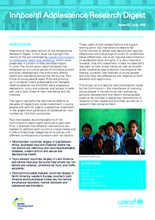Displaying 81 - 90 of 226
A PSA produced by Hillside Digital Trust about Kick4Life's work in supporting vulnerable children in Lesotho
This briefing is based on a rapid review of the available literature on outreach work with children and young people. It is intended to provide the ReachOut project with an overview of different approaches to outreach; what it generally aims to achieve; what distinguishes it from centre-based work and how it is applicable to children and young people involved in, or at risk of, child sexual exploitation.
This chapter of the Children’s Well-Being: Indicators and Research discusses the dangers of using categories in child welfare.
Each year Retrak maps the locations of family reintegration placements and tracks trends in locations over time. They have used this information to help them understand the geographic spread of children coming to the streets and to target prevention programmes on ‘’hotspots’’- places from which many children migrate to the streets.
In this study, the researchers analyze how HIV contributes to the phenomenon of child-street migration in Kenya.
This issue of Innocenti's Adolescence Research Digest includes recent news, events, and other updates as well as links to some of the latest research on adolescents and violence, health, education, street-connected youth and more.
Cet article donne un bref aperçu de la question des mendiants et des enfants de la rue dans la ville de Bujumbura, au Burundi.
This thesis investigates children’s experience of psychosocial and emotional support of (nonparental) caregivers in residential facilities in preparation for their re-integration into family based care.
The aim of this mixed-method study was to explore the trajectories of leaving home, and views and experiences among children and youth in the Kagera region in Tanzania, who have lived on the streets or been domestic workers.
This paper reflects upon lessons learned by Retrak and explores the challenges and the benefits of developing a body of evidence on reintegration good practice.




